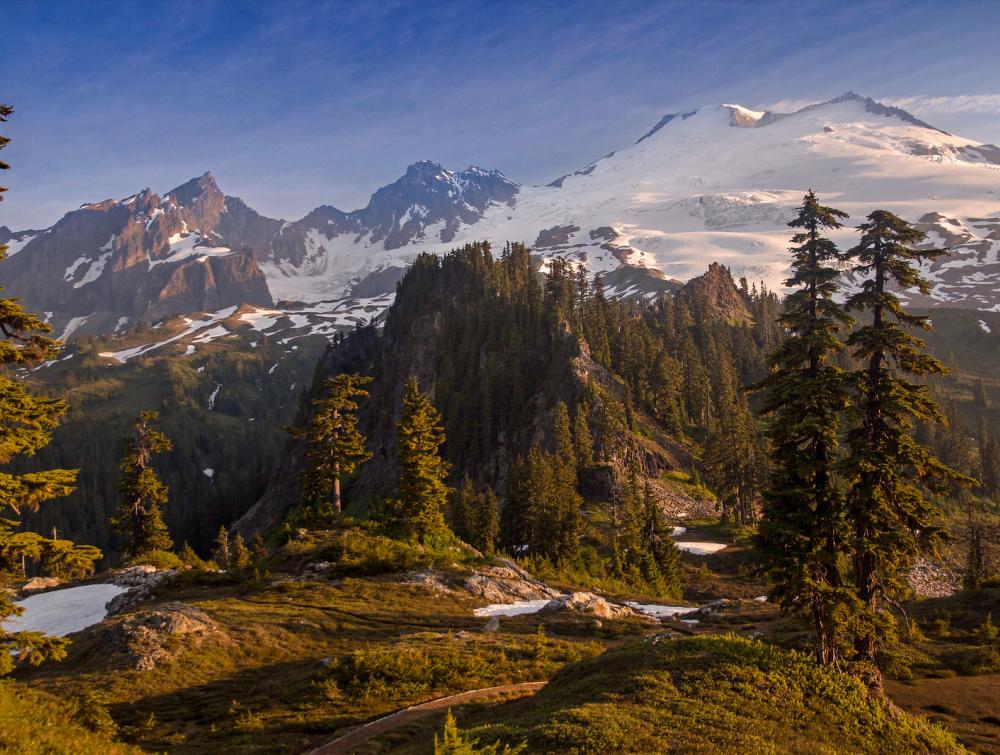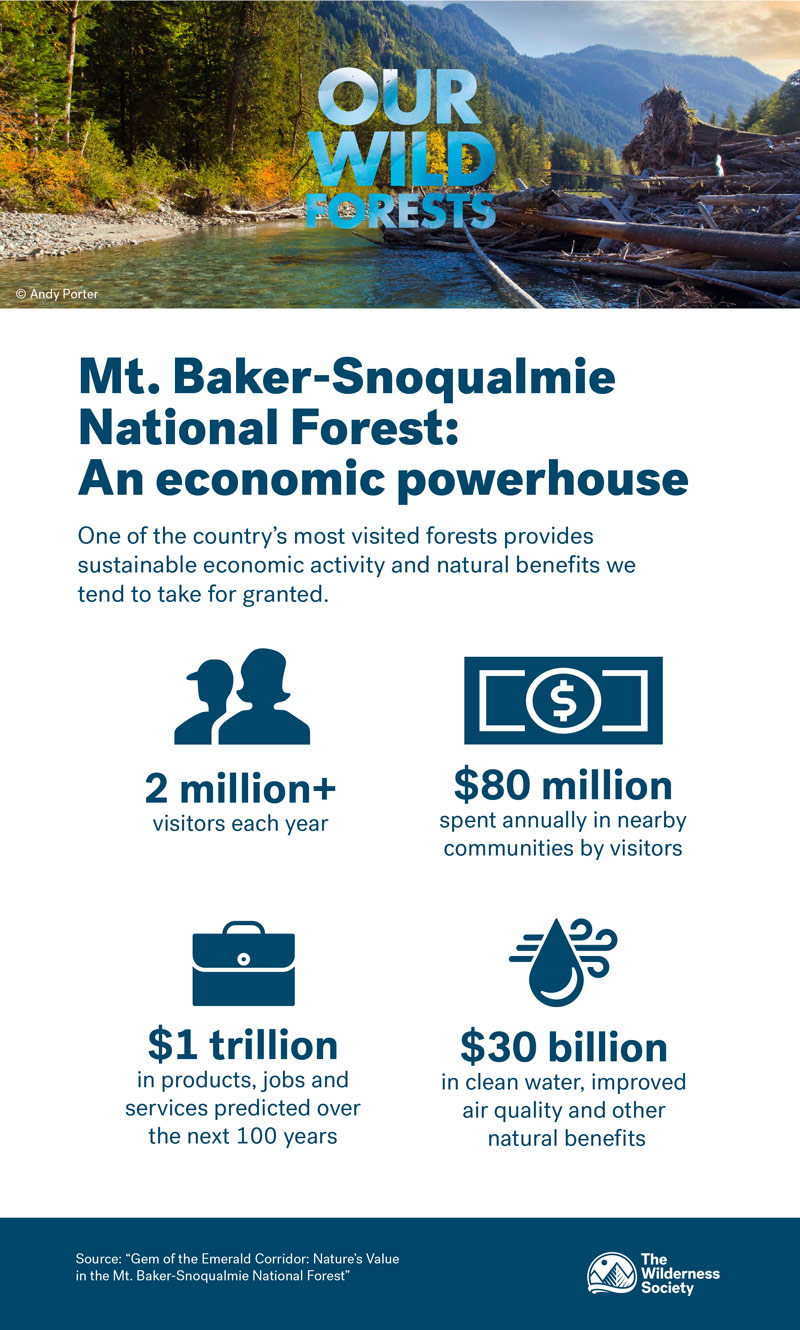What is an intact forest worth? Up to $1 trillion, in the case of Greater Seattle’s Mt. Baker-Snoqualmie

Mount Baker, WA
Andy Porter
Washington's Mt. Baker-Snoqualmie National Forest is worth up to $1 trillion in clean water, outdoor recreation and other services, a testament to the value of forests well beyond timber.
A new analysis of Mt. Baker-Snoqualmie National Forest (PDF) estimates its total value could be several times the annual revenue of Amazon.com—as much as $1 trillion.
Download full report and other resources
The study includes not only money generated from activities in the greater Seattle-area forest—for example, $25 million from downhill skiing alone--but an approximation of the clean air, water and other intangible benefits it affords under the umbrella of “ecosystem services.”
Key findings:
- Mt. Baker-Snoqualmie National Forest's total value is estimated between $159 billion and $1 trillion (for comparison’s sake, Amazon took in about $178 billion in net sales revenue in 2017)
- This forest’s value includes $30 billion worth of "ecosystem services," a measure of clean air, water and other communally beneficial services provided by the forest
- Each dollar invested in management of Mt. Baker-Snoqualmie National Forest returns over $3,000 in ecosystem services
- More than 2 million people visit Mt. Baker-Snoqualmie National Forest each year, spending an average of $90 in local economies on each trip
- The total recreational value of the Mt. Baker-Snoqualmie National Forest is more than $190 million per year
- In 2015, people doing outdoor recreation activities in the forest spent nearly $80 million on related expenses in nearby communities, supporting hundreds of local jobs

Forest’s value reflects outdoor recreation clout and ecosystem values
The outdoor recreation value of the Mt. Baker-Snoqualmie National Forest should not come as a surprise. According to a national trade group, the outdoor recreation economy generates $887 billion in consumer spending annually, directly supporting more than 200,000 jobs in Washington state alone. A recent federal report measured that impact using different criteria but largely confirmed the industry’s economic clout, estimating it comprises about 2 percent of the entire U.S. Gross Domestic Product.
The new study’s truly bold stroke comes in trying to quantify Mt. Baker-Snoqualmie “ecosystem services,” a technical term that refers to the ways a landscape benefits society. Ecosystem services may include providing wildlife habitat, filtering pollutants from water or absorbing carbon dioxide from the atmosphere.
Americans broadly value places like Mt. Baker-Snoqualmie, but since they are shared, "free" resources offering abstract benefits, nobody is specifically accountable for them and there are no inherent dollars-and-cents penalties associated with their abuse. Bundling all the forest's (frankly, incalculable) benefits into a number helps make the case for protecting public lands while assigning a price to activity that depletes them.
Forest "ecosystem services" include drinking water, clean air, and more
One of the core purposes of the National Forest System is providing and protecting clean drinking water, and Mt. Baker-Snoqualmie National Forest is estimated to provide more than $3 billion annually in water filtration and delivery alone. Forests create a water treatment network that catches rainfall, regulates storm runoff and pulls pollutants from the soil rather than allowing them to make it back to streams and rivers. About 180 million people rely on forested lands to capture or filter their drinking water, and 60 million rely on water sources that originate in national forests.
Even more apt to be taken for granted, national forests help clean the air we breathe and fight climate change. Mt. Baker-Snoqualmie National Forest provides $1.7 billion a year in ecosystem services related to improving air quality for nearby communities by intercepting pollutants and filtering air. Drawing carbon dioxide from the atmosphere as part of their natural lifecycle, trees in Mt. Baker-Snoqualmie and other national forests also constitute a rampart against man-made greenhouse gas emissions.
Mt. Baker-Snoqualmie's value even extends to its effects on Washingtonians' personal health. More than one-third of Americans are clinically obese, and physical inactivity is a huge and growing problem. The new study estimates that as they enjoy hiking and other activities, the 2 million annual visitors to the forest burn an average of 1,500 calories per visit.
Despite tremendous value, forests and land programs under attack
Even as forests like Mt. Baker-Snoqualmie drive local economies and improve quality of life, lawmakers have attacked some laws that protect or support them.
Mt. Baker-Snoqualmie was protected in part by a program called the Land and Water Conservation Fund that pays for improvements and additions to public lands. But the Trump administration and hardliners in Congress are trying to starve the Land and Water Conservation Fund, and the program is facing a year-end deadline when its authorization and funding will run out.
Additionally, some in Congress and state governments are trying to introduce reckless logging and road-building into the very wildest parts of our national forests—“roadless areas,” of which there are hundreds of thousands of acres in Mt. Baker-Snoqualmie.
With threats like these, the need for studies showing the value of forests is clear. Hopefully lawmakers will heed findings like these and support measures to keep forests like Mt. Baker-Snoqualmie wild and well-funded.
